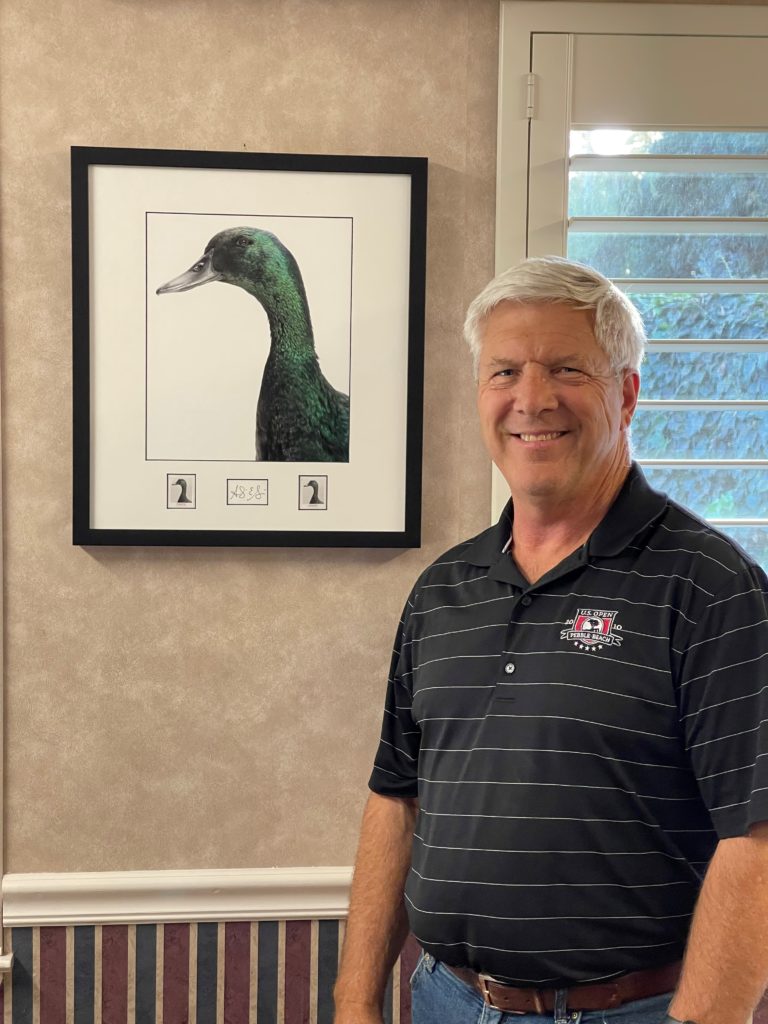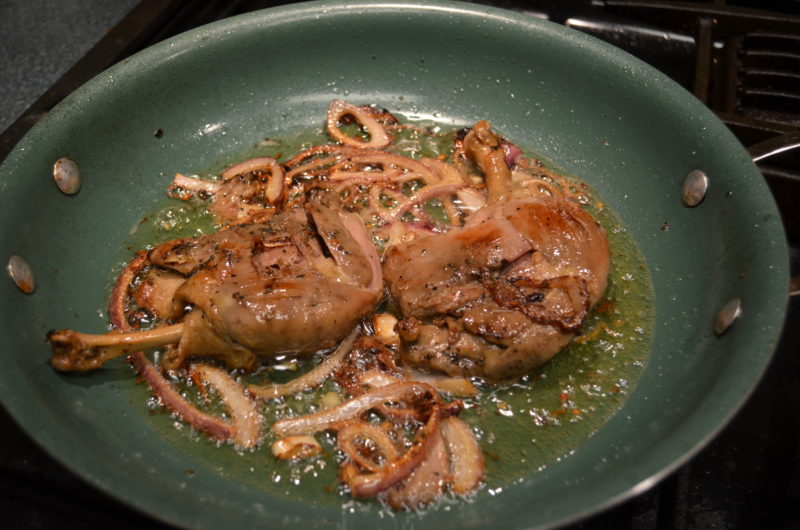Beautiful emerald green ducks with mysterious origins.
With only a simple glance, there is no mistaking the gorgeous jewel of the duck world that is the Cayuga duck. They are famously colored with a brilliant beetle green, almost metallic sheen over their entire body enabling them to glow like the finest emerald in the sun. Cayuga duck feathers are often used for fly tying and crafts as a result. The breed was known historically as Big Black duck or Lake duck it seems to have originated in New York state but their origin is a bit of a mystery.

Two young male Cayuga ducks. Courtesy of the Livestock Conservancy
Storied Past
The story goes that they were developed from a pair of wild ducks that a miller in Duchess County found on his mill pond in 1809. Thanks to some extensive sleuthing by British waterfowl historian and writer, Jonathan Thompson, the story has been found to be inaccurate and is in fact the accounting of the Gadwall duck by John J. Audubon in his 1843 book the Birds of America. There has yet to be found any clear evidence that Cayugas were developed from wild ducks in New York.
There is another piece of the mystery that includes Mr. R. Teebay of Fulwood, Preston, Lancashire, UK. He is mentioned in Lewis Wright’s The Book of Poultry where he states that these ducks largely resemble a common English black duck breed found in the region where he lived in 1860’s. He thought the Cayuga breed may have originated from these ducks. The English black duck disappeared in Lancashire.

Out of the sunlight, the Cayuga duck’s plumage can appear almost black. Photo courtesy of Livestock Conservancy
John S. Clark introduced the black ducks he attained in Orange County to Cayuga County. Cayuga is in reference to the Native American tribe found in the Finger Lakes region of New York. This is where the Cayuga got its name and over time they became a popular table bird in the area. They also had a good reputation as egg layers. The Cayuga was accepted into the American Poultry Association’s Standard of Perfection in 1847. The Cayuga remained in large numbers on New York duck farms until the Pekin duck came to dominate the duckling market in the 1880’s.
Meat and egg providers
The Cayuga is considered a medium sized duck with a long but well-rounded body. My family has experienced the excellent taste and fine quality of the Cayuga. A drawback for the breed is that it can be difficult to clean because of their dark feathering. Some people get around this by skinning the ducks rather than plucking. Their eggs are wonderful and can be used for eating and are especially good for baking purposes involving rich desserts. The differ from chicken eggs in that the whites are usually firmer. Cayugas can lay 100-150 eggs per year. What is really fascinating is that the eggs are initially almost black in color, but during the laying season, the egg color continues to lighten to light gray and then they are almost white by the end. They are sizeable eggs weighing 30-38 ounces/dozen.

Cayuga ducklings are born with dark plumage. Photo by Jeannette Beranger.
The Cayuga is recognized as one of the hardiest of the domestic ducks and are easily tamed if hand-raised. They tolerate the harsh winters and may produce many offspring. You may run into trouble with raising very small flocks for breeding because the drakes may choose a favorite and not breed with the other females. Collectively these birds could be particularly useful in sustainable agricultural efforts because of their appetite for slugs and snails that are difficult for farmers to control.
Stamp of approval
In 2020 the US Postal Service announced the creation of 10 heritage breed Forever postal stamps. Among the American breeds pictured in the series was the Cayuga duck. An unveiling ceremony was conducted at George Washington’s Mount Vernon in May of 2021 and of course we had to have a Cayuga there for attendees to see in all its glory. I heard more than one gasp as people saw the flashy ducks, never imagining an animal can be that color.

This year (2021) the U.S. Postal Service issued heritage breed animal stamps, including the Cayuga duck.

John Metzer bred Cayugas at Metzer Farms in California. Here’s John with a special framed photo of the Cayuga stamp. Photo by Marc Metzer.
Duck Delight
One of my family’s favorite ways for enjoying duck utilizes the French confit method of cooking. Basically, you slowly cook the meat at a low temperature in duck or goose fat. It takes time but it’s well worth the wait. Confit done right is a three-day process. If you have a special occasion you can prepare it well ahead of time and do the final cooking steps just before serving. You will need to get about 2 cups of fat for the dish. The popularity of French fries cooked in duck fat and made sourcing the product much easier than it used to be. We like to save up the fat from our Christmas goose and use that for the dish. It can be collected, cooled and stored in the freezer until you are ready to do the confit.

Duck confit plated with salad and mushrooms. Photo by Jeannette Beranger
The following is my husband’s recipe that we used for some Cayuga ducks provided by friends here in North Carolina. It comes out great every time!
A Proper Duck Confit
Ingredients:
1 whole duck (4-5 lbs)
2 cups of duck or goose fat drippings
1/2 – 2/3 cup of chicken stock to supplement if you don’t have enough fat to make 2 cups
Dry rub:
½ tsp salt
½ tsp cracked black pepper
½ tsp fresh minced garlic
½ tsp thyme
The first day
There are three steps over a three-day period in order to make a proper duck confit. You get started by breaking down the whole bird by removing the legs and de-boning the breasts. You must make sure the skin remains on all of the pieces. Next, cover the four pieces of the duck with the dry rub ingredients making sure to coat the inside of the separated legs then take the two pieces and press them together like closing a book with the skin side out. Do the same for the breasts with the dry rub and press the two pieces together, skin side out as you did with the legs. Put the sandwiched pieces in a covered dish and refrigerate overnight so they can marinate.
The leftover duck pieces can be used to start a stock and may be able to provide you with additional fat for the next step of your confit the next day.
Day two
The oven will need to be pre-heated to 275° F. Put the sandwiched pieces of duck in a baking dish just small enough for the meat to fill it completely. You then cover the meat with the duck or goose fat. If you do not have enough fat to cover the meat, you can add good quality poultry stock to compensate as long as it is less than a quarter of the total amount of fat used for the confit.
Cook the duck for 3 – 3 ½ hours or until the meat is fork tender or until the internal temperature reaches 165°F. Remove the dish from the oven and let the confit cool to room temperature. Keeping the duck in the baking dish, refrigerate it once again noting that all of the meat should be submerged in fat at this point.
The finishing touch on day 3
The bonus of confit is that the refrigerated duck immersed in fat can remain good to eat for up to several days since it is now properly preserved in fat. This gives you some freedom for other things the day of your occasion yet enable you to serve an elegant gourmet dish.

Heating up the confit legs. Photo by Jeannette Beranger.
When you are ready to serve the duck, heat a skillet on the stove to med-high. Drop 2 Tbs of the fat from the baking dish with the duck into the skillet and spread it across the pan to coat. Remove the duck from the baking dish with your hands and not with a spatula or fork. This is important because it will preserve the integrity of the pieces of duck. Carefully separate the sandwiched pieces from each other and place them skin side down in the hot skillet. Heat until they are ceased and heated throughout. Serve immediately.
You must be sure to serve the duck right after heating it up. The rich and flavorful confit is best paired with something light like veggies or salad.
The Cayuga duck is a fabulous addition to any hobby farm or backyard. They are easy to please and certainly pleasing to the eye.
Jeannette Beranger is the Senior Program Manager for The Livestock Conservancy. She came to the organization with 25 years’ experience working as an animal professional including veterinary and zoological institutions with a focus on Heritage breeds. She has been with The Conservancy since 2005 and uses her knowledge to plan and implement conservation programs, conduct field research, and advise farmers in their endeavors with rare breeds. She is co-author of the best-selling book An Introduction to Heritage Breeds. At home she maintains a Heritage breeds farm with a focus on rare breed chickens & horses. In 2015 she was honored as one of the top “45 Amazing Country Women in America” by Country Woman magazine for her long standing dedication to endangered breed conservation.













1 Comment
What a beauty!! Thanks for sharing this educative post.